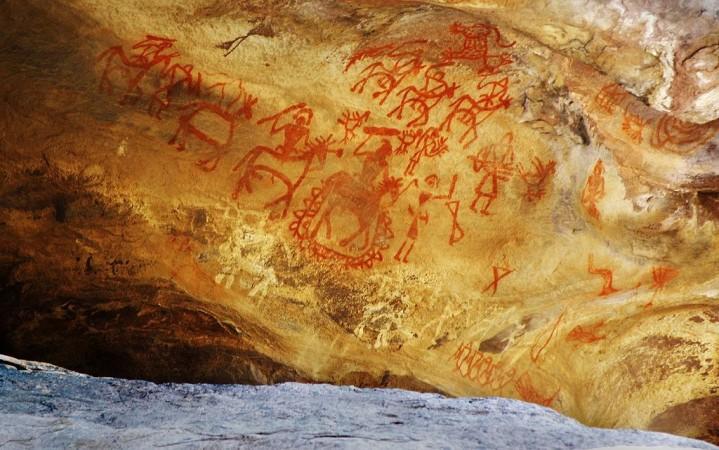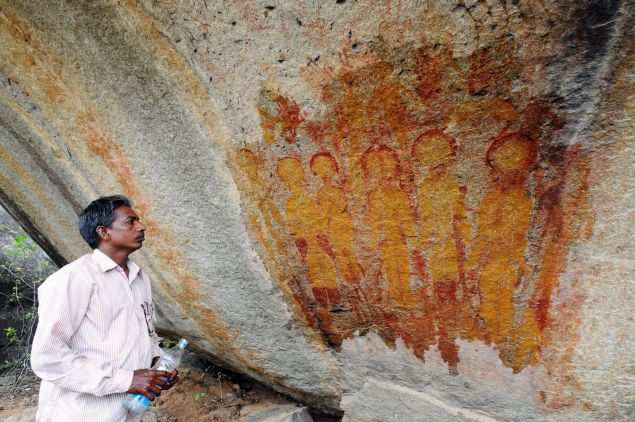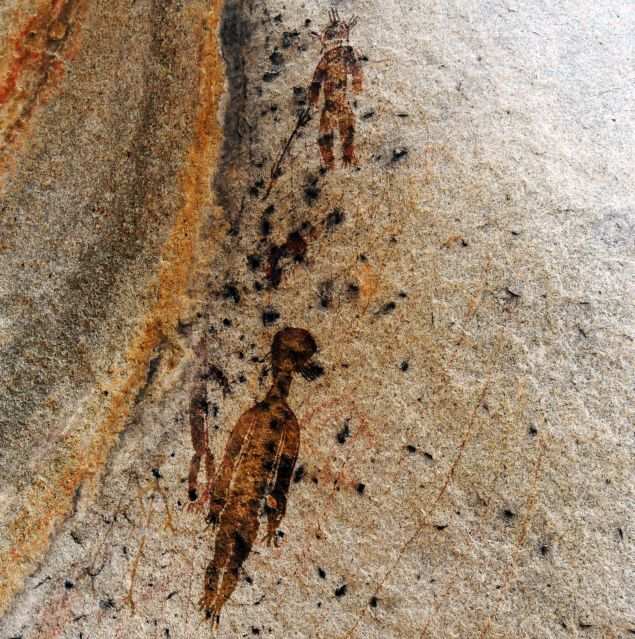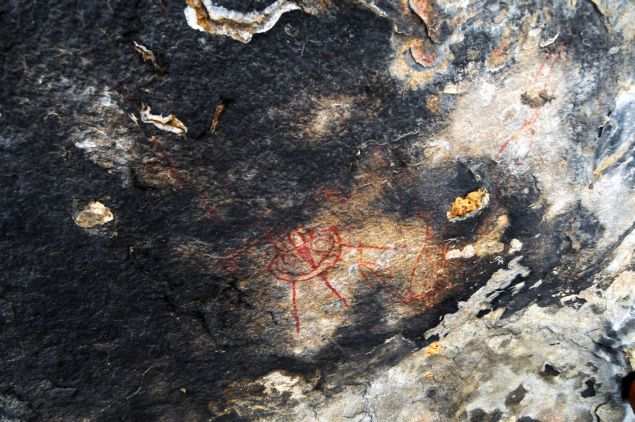10,000 Year Old Rock Paintings Depicting Aliens And UFOs Found in India
Even before the great tectonic plate shift, the former central province of India, now Madhya Pradesh and Chhattisgarh, was the site of pre-agrarian human settlement. That is why a number of prehistoric cave paintings have been discovered in the region. Some of them are known to us like Bhimbetka where we mainly find cave paintings made by a hunter-gatherer population.

Recently in the Hoshangabad district of Madhya Pradesh, just 43 miles from the local administrative centre of Raisen, ancient 10,000-year-old rock paintings depicting UFOs and extra-terrestrials have been discovered in the caves. The caves are hidden deep within the dense jungle in Charama region in Kanker district in tribal Bastar region. Located about 130km from Raipur, the caves come under village Chandeli and Gotitola.
A group of anthropologists working with hill tribes in a remote area have made a startling discovery of intricate prehistoric cave paintings depicting aliens and UFO type craft next to a look-alike ‘wormhole’ formation in the sky.

A few years back, a three-and-a-half- million-years- the old prehistoric human skull was discovered in the Ahthnor village of Madhya Pradesh by geologist Dr Arun Sonakia. Possibilities that the above image was drawn by those ancient humans can’t be ruled out, said Dr Sonakia.
The state of Chhattisgarh has an abundance of ancient rock paintings. Many sites have paintings of humans and animals in everyday scenes. However, some researchers have referred to some rather unusual paintings, such as those depicting what appear to be kangaroos and giraffes (mainly in Kabra hills of Raigarh area of the state of Chhattisgarh) which are not native to the country, as well as human-fish hybrid creatures. Now, it is claimed that aliens and UFOs can be added to this collection.
The paintings are done in natural colours that have barely faded despite the passing of years. The strangely carved figures are seen holding weapon-like objects and do not have clear features. Especially, the nose and mouth are missing. In a few pictures, they are even shown wearing spacesuits. The newly-discovered depictions date back some 10,000 years.

The images may be depicting extra-terrestrials and UFOs as the paintings include large, humanoid beings descending from the sky, some wearing what looks like a helmet or antennae, as well as a disc-shaped craft with three rays (or legs) from its base. There are several beliefs among locals from the area.
While few worship the paintings, others narrate stories they have heard from ancestors about ‘rohela people’, which translates to “the small sized ones”. According to legend, the ‘rohela people’ used to land from the sky in a round shaped flying object and take away one or two persons of village who never returned.
According to one archaeologist, the art reflects the belief among ancient humans that we are not alone in the universe. The findings suggest that humans in prehistoric times may have seen or imagined beings from other planets which still arouse curiosity among people and researchers.
Archaeologists typically identify them as ‘shamanic’ images of humans, or human-animal hybrids, and geometric forms. Images of figures with antlers, antennae, or spiritual rays are familiar, and in fact quite common, in shamanic art.
A clear image of what might be an alien or ET in a spacesuit can be seen in above a cave painting along with a classical flying saucer-shaped UFO that appears to be either beaming something down or beaming something up, in what might be an ancient UFO abduction scenario.
A force-field or trail of some sort is seen at the rear of the UFO. Also visible is another object that might depict a wormhole, explaining how aliens were able to reach Earth. Down below is the wormhole. The concept was discussed by physicist Stephen Hawking but in a skeptical manner. But isn’t it fascinating that ancient Indian possibly witnessed wormholes, UFO and alien visitations while Stephen Hawking remained skeptic about them?
Local archaeologist, Mr Wassim Khan, has personally seen the images. He claims that the objects and creatures seen in them are totally anomalous and out of character when compared to other, already discovered, examples of prehistoric cave art depicting ancient life in the area. As such, he believes that they might suggest beings from other planets have been interacting with humans since prehistoric times.
It may be better explained that encounters like this helped ancient Indian civilization to understand how those alien spaceship worked and later documented in ‘Vimana shastra’. This explanation, in turn, establishes the ‘ancient astronaut theory’ which postulates that human civilization was established with the assistance of benevolent space-travelling aliens.
On enlargement, two objects that look like hats floating in mid-air can be noticed, as also one of them appears to have portholes on it. Indian Vedic texts are full of descriptions of Vimanas. The Ramayana describes Vimanas as a double-decked, circular or cylindrical aircraft with portholes and a dome. It flew with “the speed of the wind” and made a “melodious sound”.

It is not uncommon in Madhya Pradesh that commoners claiming sight of UFO in nearby areas till this date. The latest entrant to the list of people in Madhya Pradesh that have claimed to have seen Unidentified Flying Objects (UFO), states Agriculture and Fisheries Minister Ramkrishna Kusmaria in July 2014.
Kusmaria said while he was on an official tour he spotted a UFO in Sukha village in Damoh district, about 135 miles from ancient cave painting site. Kusmaria said he clearly saw the object in the sky, and it was emitting sharp sparks. “The object caused damage to the standing crops in the area. I saw papaya fruits fall off the tree as the UFO passed by,” the minister said.
The State Department of Archaeology and Culture in Chhattisgarh is seeking assistance from the Indian Space Research Organisation to research a set of ancient rock paintings found inside caves near the town of Charama in Kanker district, in the tribal Bastar region.





